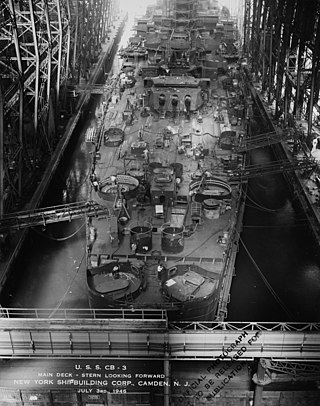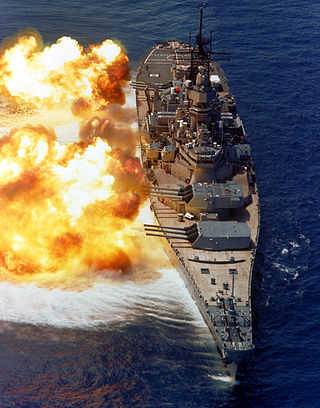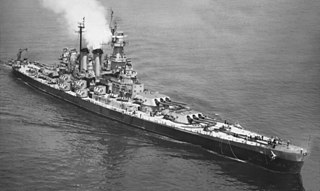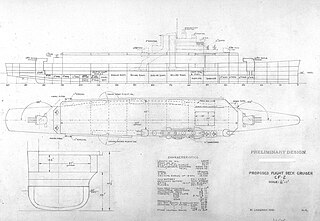Related Research Articles

An aircraft carrier is a warship that serves as a seagoing airbase, equipped with a full-length flight deck and facilities for carrying, arming, deploying, and recovering aircraft. Typically it is the capital ship of a fleet, as it allows a naval force to project air power worldwide without depending on local bases for staging aircraft operations. Carriers have evolved since their inception in the early twentieth century from wooden vessels used to deploy balloons to nuclear-powered warships that carry numerous fighters, strike aircraft, helicopters, and other types of aircraft. While heavier aircraft such as fixed-wing gunships and bombers have been launched from aircraft carriers, these aircraft have not landed on a carrier. By its diplomatic and tactical power, its mobility, its autonomy and the variety of its means, the aircraft carrier is often the centerpiece of modern combat fleets. Tactically or even strategically, it replaced the battleship in the role of flagship of a fleet. One of its great advantages is that, by sailing in international waters, it does not interfere with any territorial sovereignty and thus obviates the need for overflight authorizations from third-party countries, reduces the times and transit distances of aircraft and therefore significantly increases the time of availability on the combat zone.

USS New Jersey (BB-62) is an Iowa-class battleship, and was the second ship of the United States Navy to be named after the U.S. state of New Jersey. She was often referred to fondly as "Big J". New Jersey earned more battle stars for combat actions than the other three completed Iowa-class battleships, and was the only US battleship used to provide gunfire support during the Vietnam War.

USS Kentucky (BB-66) was an uncompleted battleship intended to be the last ship of the Iowa class. Hull BB-66 was originally to be the second ship of the Montana-class battleships. However, the urgent need for more warships at the outbreak of World War II and the U.S. Navy's experiences in the Pacific theater led it to conclude that rather than battleships larger and more heavily armed than the Iowa class, it quickly needed more fast battleships of that class to escort the new Essex-class aircraft carriers being built. As a result, hulls BB-65 and BB-66 were reordered and laid down as Iowa-class battleships in 1942.

USS Illinois (BB-65) was the fifth Iowa-class fast battleship that was laid down for the United States Navy during World War II in the 1940s, although she would not be completed. The Navy had initially planned on building four of the Iowas and then developing a new, more powerful ship for what was to be BB-65. The pressing need for more warships at the outbreak of World War II in Europe led the Navy to conclude that new designs would have to be placed on hold to allow the shipbuilding industry to standardize on a small number of designs. As a result, BB-65 was ordered to the Iowa design in 1940. Illinois was laid down in December 1942, but work was given a low priority, and was still under construction at the end of World War II. She was canceled in August 1945, but her hull remained as a parts hulk until she was broken up in 1958.

USS Wisconsin (BB-64) is an Iowa-class battleship built for the United States Navy (USN) in the 1940s and is currently a museum ship. Completed in 1944, the ship was assigned to the Pacific Theater during World War II, where she participated in the Philippines campaign and the Battles of Iwo Jima and Okinawa. The battleship shelled the Japanese home islands shortly before the end of the war in September 1945. During the Korean War, Wisconsin shelled North Korean targets in support of United Nations and South Korean ground operations, after which she was decommissioned. She was reactivated in 1986; after a modernization program, she participated in Operation Desert Storm in January – February 1991.

USS Hawaii (CB-3) was intended to be the third member of the Alaska-class large cruisers. It was the first United States Navy ship to be named after the then-Territory of Hawaii. Because Hawaii's construction was delayed by higher-priority ships like aircraft carriers, her keel was not laid until December 1943, about two years after her sister ship Guam.

A warship or combatant ship is a ship that is used for naval warfare. Usually they belong to the navy branch of the armed forces of a nation, though they have also been operated by individuals, cooperatives and corporations. As well as being armed, warships are designed to withstand damage and are typically faster and more maneuverable than merchant ships. Unlike a merchant ship, which carries cargo, a warship typically carries only weapons, ammunition and supplies for its crew.

The Iowa class was a class of six fast battleships ordered by the United States Navy in 1939 and 1940. They were initially intended to intercept fast capital ships such as the Japanese Kongō class and serve as the "fast wing" of the U.S. battle line. The Iowa class was designed to meet the Second London Naval Treaty's "escalator clause" limit of 45,000-long-ton (45,700 t) standard displacement. Beginning in August 1942, four vessels, Iowa, New Jersey, Missouri, and Wisconsin, were completed; two more, Illinois and Kentucky, were laid down but canceled in 1945 and 1958, respectively, before completion, and both hulls were scrapped in 1958–1959.

The capital ships of a navy are its most important warships; they are generally the larger ships when compared to other warships in their respective fleet. A capital ship is generally a leading or a primary ship in a naval fleet.

The North Carolina class were a pair of fast battleships, North Carolina and Washington, built for the United States Navy in the late 1930s and early 1940s.

The Alaska-class were six large cruisers ordered before World War II for the United States Navy (USN), of which only two were completed and saw service late in the war. The USN designation for the ships of this class was 'large cruiser' (CB), a designation unique to the Alaska-class, and the majority of leading reference works consider them as such. However, various other works have alternately described these ships as battlecruisers despite the USN having never classified them as such, and having actively discouraged the use of the term in describing the class. The Alaskas were all named after territories or insular areas of the United States, signifying their intermediate status between larger battleships and smaller heavy and light cruisers.
The names of commissioned ships of the United States Navy all start with USS, for United States Ship. Non-commissioned, primarily civilian-crewed vessels of the U.S. Navy under the Military Sealift Command have names that begin with USNS, standing for United States Naval Ship. A letter-based hull classification symbol is used to designate a vessel's type. The names of ships are selected by the Secretary of the Navy. The names are those of states, cities, towns, important persons, important locations, famous battles, fish, and ideals. Usually, different types of ships have names originated from different types of sources.

A magazine is an item or place within which ammunition or other explosive material is stored. The word is taken originally from the Arabic word makhāzin (مخازن), meaning "storehouses", via Italian and Middle French.

The Ise-class battleships were a pair of dreadnought battleships built for the Imperial Japanese Navy (IJN) during World War I. Both ships carried supplies for the survivors of the Great Kantō earthquake in 1923. They were modernized in 1934–1937 with improvements to their armour and machinery and a rebuilt superstructure in the pagoda mast style. Afterwards they played a minor role in the Second Sino-Japanese War.

The South Dakota class was a group of four fast battleships built by the United States Navy. They were the second class of battleships to be named after the 40th state; the first were designed in the 1920s and canceled under the terms of the Washington Naval Treaty. Four ships comprised the class: South Dakota, Indiana, Massachusetts, and Alabama. They were designed to the same treaty standard displacement limit of 35,000 long tons (35,600 t) as the preceding North Carolina class and had the same main battery of nine 16"/45 caliber Mark 6 guns in three-gun turrets, but were more compact and better protected. The ships can be visually distinguished from the earlier vessels by their single funnel, compared to twin funnels in the North Carolinas.
The Joffre class consisted of a pair of aircraft carriers ordered by the Marine Nationale prior to World War II. The Navy had commissioned an experimental carrier in 1927, but it was slow and obsolete by the mid-1930s. Support for naval aviation in the navy was weak during this time as it had lost control of its aircraft, its training and their development to the new Air Ministry when it formed in 1928 and did not regain full control until 1936. Traditionalists among the naval leadership had begun a battleship building program in the early 1930s to counter German ships that were suitable for commerce raiding and carriers were deemed useful to hunt them down, especially once the Germans began building a carrier of their own in 1936.

The Iowa-class battleships are the most heavily armed warships the United States Navy has ever put to sea, due to the continual development of their onboard weaponry. The first Iowa-class ship was laid down in June 1940; in their World War II configuration, each of the Iowa-class battleships had a main battery of 16-inch (406 mm) guns that could hit targets nearly 20 statute miles (32 km) away with a variety of artillery shells designed for anti-ship or bombardment work. The secondary battery of 5-inch (127 mm) guns could hit targets nearly 9 statute miles (14 km) away with solid projectiles or proximity fuzed shells, and was effective in an anti-aircraft role as well. Each of the four battleships carried a wide array of 20 mm and 40 mm anti-aircraft guns for defense against enemy aircraft.

The aircraft cruiser is a warship that combines the features of the aircraft carrier and a surface warship such as a cruiser or battleship.

The United States battleship retirement debate was a debate among the United States Navy, Marine Corps, Congress, and independent groups over the effectiveness of naval gunfire support (NGFS) provided by Iowa-class battleships, and whether an alternative should be implemented. The debate centered on the best way to provide fire support for amphibious assault and other troops near a shoreline.

The flight-deck cruiser was a proposed type of aircraft cruiser,, designed by the United States Navy during the Interwar period. Several designs were proposed for the type, but none was approved for construction. The final design was developed just before World War II, and the entry of the United States into the war saw the project come to an end.
References
- ↑ Mizokami, Kyle (April 26, 2019). "The Ultimate Warship: A Hybrid Aircraft Carrier-Battleship?". The National Interest.
- ↑ Muir 1989, p. 130.
- ↑ "Cold War Battleships – Platforms That Never Were". Baloogan Campaign.
- ↑ "The Iowa-Class Battlecarrier: A Design that Never & "Took Off"". Naval history. June 28, 2019.
- ↑ "USS Tinian: Assault Conversion for the Iowa Class". Steel navy. Archived from the original on 2021-05-16. Retrieved January 1, 2022.
- ↑ "WWII Battleships as Marine Heavy Assault Ship?". Grunts & Co. December 8, 2013.